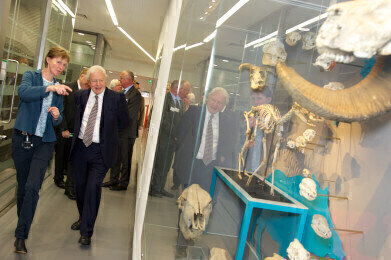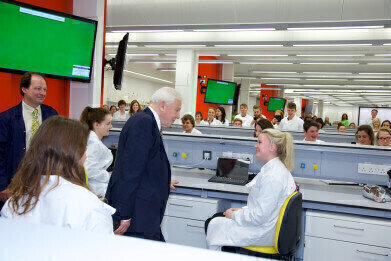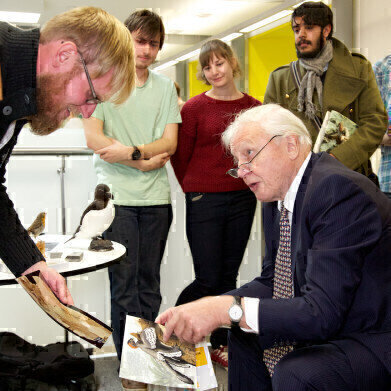-
 Sir David Attenborough tours the Life Sciences Building's facilities. All pictures credit: Nick Smith/University of Bristol
Sir David Attenborough tours the Life Sciences Building's facilities. All pictures credit: Nick Smith/University of Bristol -

-

News & Views
Iconic Life Sciences Centre Launched by Sir David Attenborough
Oct 12 2014
Renowned broadcaster and naturalist Sir David Attenborough officially opened the University of Bristol’s new £56.5 million Life Sciences building on October 6, a focal point where biologists, chemists, computer scientists, engineers, mathematicians and earth scientists work together to establish how lessons learned from nature can benefit society.
The University’s biggest construction project to-date supports an exterior living wall, rising over 20 metres above street level and home to 11 different species of plant with boxes for birds and bats. The rooftop GroDome, built by controlled environmental chamber and glasshouses specialist Unigro is capable of recreating tropical conditions by controlled light, humidity and temperature.
Designed with high sustainability and energy efficiency, ventilated heat and collected rainwater are reused, blinds lower automatically in bright light and lighting has been designed to avoid pollution of the night sky.
Professor Gary Foster, Professor of Molecular Plant Pathology, said: “We wanted to create a unique building which reflected the activities going on inside. The result is stunning inside and out, and finished to a very high standard.
“The amazing green wall and two green roofs certainly act as an advertisement for the exciting research and teaching that will go on in the new building, visible to everyone in the surrounding area and city.
“The Life Sciences building provides outstanding laboratories for science teaching and will enhance the undergraduate experience by facilitating research-led study and staff-student interaction, making Bristol University the first choice for research and teaching in this area."
Designed by the architects Sheppard Robson and built by VINCI UK, construction of the 13,500 square metre building began in July 2011; a total of 2,000 people have worked on the project, including 28 architects from 10 countries. Nicholas Pearson Associates, redesigned the space around the building with 21 trees and 3,215m2 of shrubs and grasses.
With one of the largest teaching labs in the country the life Sciences building is capable of teaching 200 students at once. The five-storey laboratory wing boasts acoustic chambers for bat research, an insectarium, labs for studying ant and bee behaviour, spectroscopy and microscope rooms. Focusing on plant sciences and animal behaviour, the centre is also home to some of the country’s leading paleobiologists who are using the latest technology to learn more about dinosaurs and evolution.
Digital Edition
Lab Asia 31.2 April 2024
April 2024
In This Edition Chromatography Articles - Approaches to troubleshooting an SPE method for the analysis of oligonucleotides (pt i) - High-precision liquid flow processes demand full fluidic c...
View all digital editions
Events
Apr 28 2024 Montreal, Quebec, Canada
May 05 2024 Seville, Spain
InformEx Zone at CPhl North America
May 07 2024 Pennsylvania, PA, USA
May 14 2024 Oklahoma City, OK, USA
May 15 2024 Birmingham, UK

















